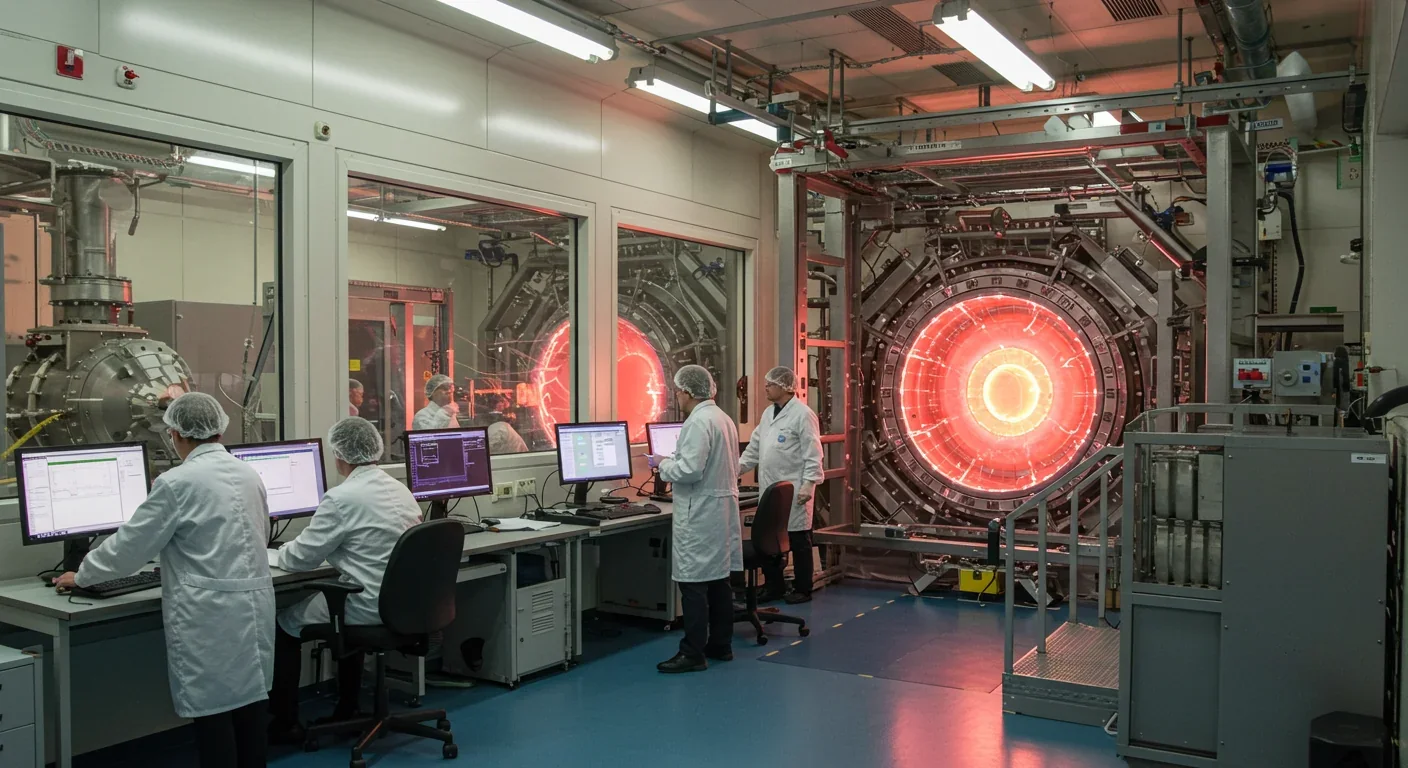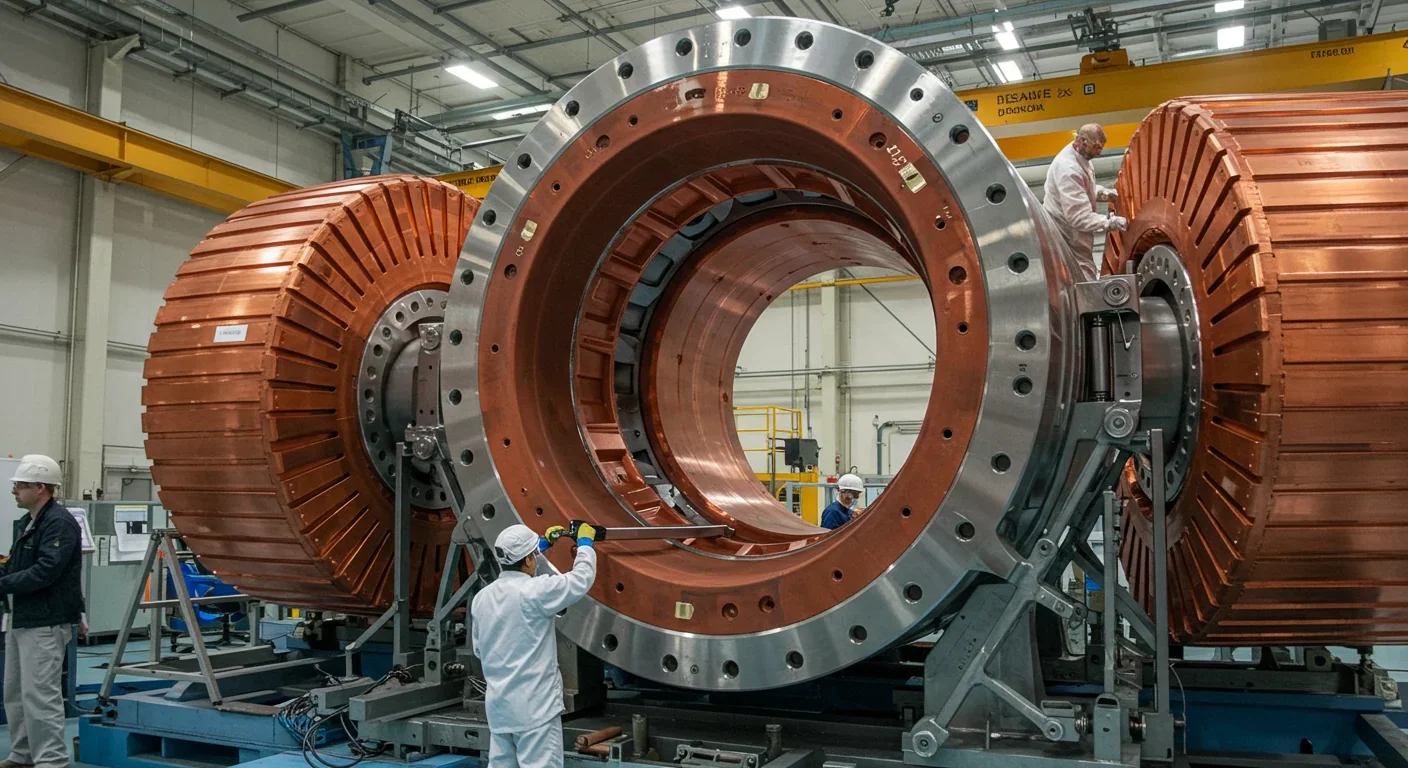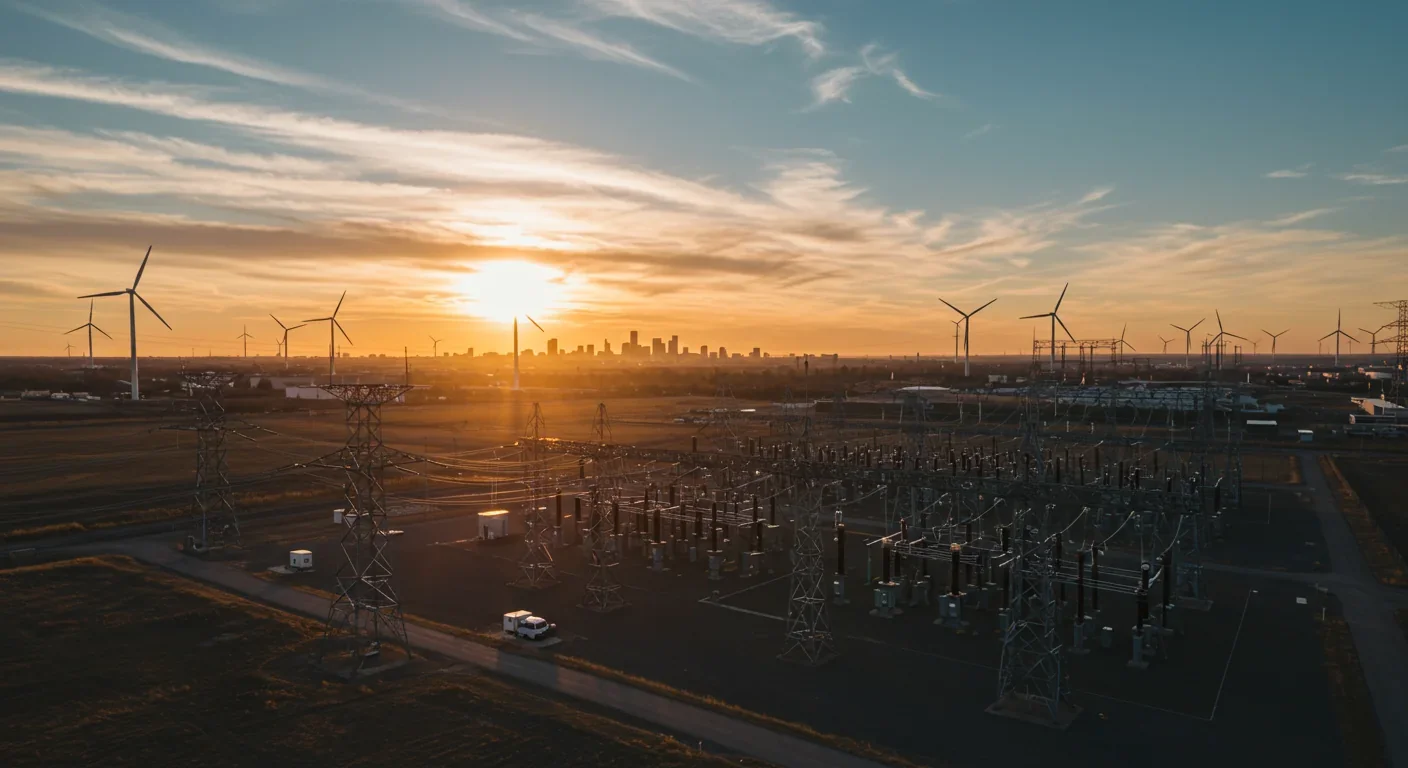Digital Pollution Tax: Can It Save Data Centers?

TL;DR: Fusion energy has moved from science fiction to reality with breakthrough achievements and billion-dollar commercial deals. While technical challenges remain, the next decade will determine if fusion can deliver unlimited clean energy fast enough to transform our climate and civilization.

By 2035, the world's first commercial fusion power plants could be feeding electricity into the grid—not as a far-off dream, but as operational facilities transforming how humanity generates energy. After decades of skepticism and false starts, fusion energy has entered a new phase where major utilities are signing billion-dollar deals, governments are committing unprecedented funding, and breakthrough after breakthrough suggests we're on the verge of harnessing the power of stars here on Earth.
Unlike fission reactors that split atoms and produce radioactive waste lasting millennia, fusion promises something revolutionary: nearly limitless energy from abundant fuel sources, minimal radioactive byproducts, and no risk of catastrophic meltdowns. The question isn't whether fusion will work anymore. It's how quickly we can scale it.
December 2022 marked a turning point. For the first time in history, scientists at Lawrence Livermore National Laboratory achieved fusion ignition—producing more energy from a fusion reaction than the lasers put in to trigger it. The National Ignition Facility fired 192 lasers at a tiny capsule containing hydrogen isotopes, creating temperatures exceeding 100 million degrees Celsius and pressures found nowhere else in the universe except inside stars and exploding nuclear weapons.
The reaction lasted nanoseconds but yielded 3.15 megajoules of energy from 2.05 megajoules input. That 50% energy gain shattered a barrier physicists had been chasing since the 1950s. Even more remarkably, they've since repeated the achievement multiple times, proving it wasn't a fluke.
This wasn't just a scientific curiosity. It demonstrated that the fundamental physics of fusion energy works. The challenge now shifts from "can we do it?" to "can we do it repeatedly, affordably, and at scale?"
The story of fusion begins not with energy generation but with understanding thermonuclear weapons. After World War II, physicists realized that if they could control the fusion reactions powering hydrogen bombs, humanity could tap an energy source dwarfing anything else available. The fuel—deuterium and tritium, both isotopes of hydrogen—exists in seawater and can be synthesized. One kilogram of fusion fuel contains energy equivalent to 10 million kilograms of fossil fuel.
Early pioneers thought commercial fusion was 20 years away. That was in the 1960s.
What followed was a grinding reality check. Containing plasma at 150 million degrees Celsius—ten times hotter than the sun's core—proved almost impossibly difficult. Plasma is ionized gas where electrons break free from atoms, creating a roiling soup of charged particles. Touch anything solid and it instantly cools, ending the reaction. Early tokamak reactors in the Soviet Union used powerful magnetic fields to suspend plasma in a donut-shaped chamber, but instabilities caused plasma to escape or cool before fusion could occur efficiently.
Progress came in inches. Scientists learned to shape magnetic fields more precisely, developed superconducting magnets that don't overheat, and figured out how to heat plasma using radio waves and particle beams. Each advance brought fusion closer but never quite close enough.
Walk into the ITER construction site in southern France and you're witnessing the most complex engineering project humanity has ever attempted. Thirty-five nations—including the US, EU, China, India, Russia, Japan, and South Korea—are collaborating to build a tokamak reactor so large and powerful it will conclusively demonstrate fusion's viability.
At its heart sits a central solenoid magnet that's almost absurdly powerful. Completed by General Atomics after 15 years of development, this magnet stands 60 feet tall, weighs 1,000 tons, and stores 6.4 gigajoules of magnetic energy. It generates a 13-tesla magnetic field—260,000 times stronger than Earth's magnetic field—and can sustain a 15-megaampere current for up to 500 seconds.
Why does this matter? Because ITER's plasma chamber will hold 840 cubic meters of hydrogen plasma heated to 150 million degrees. The magnetic field must be strong enough to keep every atom of that plasma suspended in the center of the chamber, never touching the walls, while fusion reactions generate enormous heat and radiation. The central solenoid also drives current through the plasma itself, heating it and controlling instabilities.
Each of the six solenoid modules required over two years to fabricate, using niobium-tin superconducting cable produced in Japan and wound into coils with microscopic precision. The modules had to survive testing at near absolute zero, then be shipped to France and stacked like impossibly delicate building blocks.
ITER aims to produce 500 megawatts of fusion power from 50 megawatts of heating input—a tenfold energy gain. If successful, it proves fusion can generate vastly more energy than it consumes, clearing the path for commercial reactors.
While ITER represents the international scientific establishment's bet on fusion, a wave of private companies are racing to beat it to market with smaller, faster, cheaper designs.
Commonwealth Fusion Systems, spun out of MIT in 2018, recently signed a $1.5 billion power purchase agreement with Constellation Energy—the largest such deal in fusion history. Their SPARC reactor uses breakthrough high-temperature superconducting magnets to create stronger magnetic fields in a much smaller device. SPARC is roughly the size of a tennis court versus ITER's footprint of 60 soccer fields.
The company projects that SPARC will achieve burning plasma—where the fusion reactions themselves generate enough heat to sustain the reaction without external heating—by the late 2020s. Their commercial follow-on, ARC, could be producing electricity for the grid by 2035.
Type One Energy Group, developing stellarator-based fusion (a twisted cousin of the tokamak), partnered with Tennessee Valley Authority to build a 350-megawatt fusion plant capable of powering hundreds of thousands of homes. Stellarators don't require driving current through plasma, potentially making them more stable and easier to run continuously.

First Light Fusion in the UK is pursuing an entirely different approach called inertial confinement fusion. They fire projectiles at fusion fuel pellets at hypersonic speeds, compressing them so rapidly that fusion occurs before the fuel can escape. Their published research describes a "plausible path to high gain" that could make fusion energy remarkably cheap—potentially cheaper than current renewables.
Investment is flooding in. Fusion startups raised record amounts despite broader climate tech funding declining. Governments are committing too. The US Department of Energy's Milestone-Based Fusion Development Program is providing hundreds of millions to accelerate private fusion efforts.
Here's the part that doesn't make headlines but could determine fusion's success: the fuel cycle.
Fusion reactors burn deuterium and tritium. Deuterium is plentiful—you can extract it from seawater at minimal cost. But tritium is radioactive with a 12-year half-life and doesn't exist naturally in significant quantities. We currently produce tiny amounts in fission reactors.
A commercial fusion reactor will need kilograms of tritium annually. There's not nearly enough supply.
The solution is breeding tritium inside the reactor itself. Fusion reactions produce high-energy neutrons. Surround the plasma with a "blanket" containing lithium, and those neutrons will collide with lithium atoms, producing tritium that you extract and feed back into the reactor. The UK Atomic Energy Authority is developing LIBRTI (Lithium Blanket Reactor Technology and Innovation) to solve this problem.
Get the breeding ratio wrong—produce less tritium than you consume—and your reactor becomes parasitic, dependent on external tritium supplies that don't exist. Achieve a breeding ratio above 1.0 and your reactor becomes self-sustaining, even producing surplus tritium for starting up additional reactors.
Tritium breeding adds complexity. The blanket must withstand intense neutron bombardment, corrosive lithium coolant, and temperatures exceeding 500°C while reliably extracting tritium. It's simultaneously a nuclear fuel factory, coolant system, and neutron shield. International collaboration through IAEA meetings is pushing forward blanket technology because no single nation can solve this alone.
Imagine a world where energy scarcity vanishes.
Not slowly. Not incrementally. But fundamentally and permanently.
Fusion fuel exists in quantities that dwarf current energy resources. The deuterium in Earth's oceans could power human civilization at current consumption rates for billions of years. Lithium for tritium breeding is abundant in seawater and mineral deposits. Unlike uranium for fission, there's no geopolitical chokehold on fusion fuel.
Climate impact becomes manageable. Fusion produces no greenhouse gases, no long-lived radioactive waste, and no risk of meltdown. The radioactive materials it does produce—activated reactor components exposed to neutron bombardment—lose most radioactivity within decades rather than millennia. You could theoretically recycle fusion reactor materials after a century.
Energy becomes dramatically cheaper. Fusion fuel costs are negligible. Operating costs depend on reactor efficiency, but analysis by MIT researchers suggests fusion electricity could eventually undercut even modern renewables. When energy is abundant and cheap, everything else becomes cheaper too.
Water desalination becomes trivial. Currently, it's energy-intensive and expensive, limiting availability. With fusion, coastal nations could desalinate seawater at scale. Food production could move indoors under LED lighting, reducing land use and eliminating agricultural runoff.
Direct air capture of CO₂ becomes economically viable. These systems are too energy-hungry to scale with current technology. Fusion makes them feasible, potentially allowing us to reverse past emissions.
Manufacturing transforms. Energy-intensive processes like producing steel, aluminum, cement, and chemicals currently account for nearly 30% of global emissions. Fusion power eliminates those emissions while making production cheaper.
Not everyone shares this optimism.
Some physicists point out persistent technical hurdles. Plasma instabilities remain poorly understood and can disrupt reactions unpredictably. Materials science hasn't caught up to the need for components that can withstand decades of neutron bombardment without becoming brittle or radioactive. Even ITER, with all its resources and international cooperation, has faced repeated delays and cost overruns, with some estimates now exceeding $65 billion.
The timelines keep slipping. Predictions that commercial fusion would arrive by 2030 now point to 2035 or 2040. Private companies make bold claims about near-term deployment, but actually building, licensing, and operating the first commercial reactors will take longer than anyone admits publicly.
Economic viability remains uncertain. Fusion reactors are extraordinarily complex. Will they compete with ever-cheaper solar panels and wind turbines? Renewables combined with batteries are improving so rapidly that fusion might arrive only to find the energy market doesn't need it. The US Energy Secretary's prediction of fusion powering the world in 8-15 years sounds more like wishful thinking than hard analysis.

And there's an awkward question nobody wants to address: What if fusion power is clean but not cheap enough? The nuclear fission industry promised electricity "too cheap to meter" and instead delivered power plants costing billions and taking decades to build. Could fusion follow the same trajectory?
While Western nations and companies dominate headlines, China is quietly making massive investments in fusion research.
France recently broke records by maintaining a tokamak plasma for 22 continuous minutes, demonstrating the long-duration stability required for power generation. China's "artificial sun" project achieved plasma temperatures of 120 million degrees Celsius for over 17 minutes.
Chinese scientists developed superconducting magnets producing record magnetic fields essential for compact fusion reactors. China's Experimental Advanced Superconducting Tokamak in Anhui has achieved multiple milestones in plasma confinement.
This isn't just scientific prestige. Whoever achieves commercial fusion first gains enormous economic and geopolitical advantages. Energy independence becomes attainable for any nation with access to seawater. Energy exports—currently a cornerstone of global economics and power dynamics—diminish in importance.
The fusion race also represents a test of different systems. Can China's centralized, state-directed model outpace the West's mix of international collaboration and private sector innovation? ITER exemplifies democratic cooperation across rivals. Commonwealth Fusion and others represent venture capital betting on disruption. China combines both: state investment in fundamental research while allowing private companies to compete.
Whoever wins, humanity wins. But the winner also writes the rules for how fusion power deploys globally.
If—or more likely, when—fusion succeeds, society faces massive adjustments.
Electric grids need complete redesign. Current grids balance variable renewable generation with dispatchable fossil fuel plants. Fusion plants will run continuously at high capacity, generating steady baseload power. That requires rethinking transmission infrastructure, grid storage, and electricity markets designed around fuel costs that fusion won't have.
Workforce transitions will be dramatic. Fossil fuel industries employ millions globally. Fusion requires different skills—plasma physics, superconducting magnet engineering, advanced materials science. Nations must begin training this workforce now, or they'll lack the human capital to deploy fusion when it arrives.
New international frameworks for fusion regulation, safety standards, and fuel supply chains need development. Unlike nuclear fission with its weapons proliferation risks, fusion poses minimal weapons threat. That could enable more relaxed international cooperation and technology sharing, but standards must be harmonized to prevent accidents and ensure public trust.
And we'll face a philosophical question: What do we do with unlimited clean energy?
Do we use it to maintain current lifestyles with less environmental damage? Or does it enable entirely new modes of living we haven't imagined? Does it drive space exploration, making off-world mining and colonization feasible? Does it power direct air capture at massive scale, allowing us to reverse climate change rather than merely halt it?
The answer depends on choices we make now.
Nuclear fusion sits at a strange intersection—simultaneously closer than ever and still frustratingly out of reach.
The physics works. ITER's superconducting magnets are complete and being assembled. Commonwealth Fusion Systems has a billion-dollar deal to deliver actual power. Multiple reactor designs are converging toward solutions. Even alternative approaches like mining nuclear waste for fusion fuel are gaining traction as scientists explore every possible pathway to abundant clean energy.
The engineering is advancing. Materials that can withstand neutron bombardment for decades are in development. Superconducting tape technology is making smaller, more powerful magnets possible. Tritium breeding blankets are moving from concept to prototype.
The money is flowing. Private investment, government funding, and utility commitments signal that fusion is transitioning from research project to industry.
What's missing is time and persistence. Every major energy transition took decades. Coal to oil. Oil to electricity. Fossil fuels to renewables. Fusion won't be different. The next 10-15 years will determine whether it succeeds, but even if successful, widespread adoption will extend into the second half of this century.
The question isn't whether fusion can work. It's whether we can scale it fast enough to matter for climate change, deploy it broadly enough to democratize energy access, and manage the transition wisely enough to avoid the pitfalls that plagued nuclear fission.
For the first time in human history, we're on the verge of taming the power of stars. What we do with that power will define the next chapter of human civilization. The fusion age isn't coming eventually—it's arriving now, one megajoule at a time.

Recent breakthroughs in fusion technology—including 351,000-gauss magnetic fields, AI-driven plasma diagnostics, and net energy gain at the National Ignition Facility—are transforming fusion propulsion from science fiction to engineering frontier. Scientists now have a realistic pathway to accelerate spacecraft to 10% of light speed, enabling a 43-year journey to Alpha Centauri. While challenges remain in miniaturization, neutron management, and sustained operation, the physics barriers have ...

Epigenetic clocks measure DNA methylation patterns to calculate biological age, which predicts disease risk up to 30 years before symptoms appear. Landmark studies show that accelerated epigenetic aging forecasts cardiovascular disease, diabetes, and neurodegeneration with remarkable accuracy. Lifestyle interventions—Mediterranean diet, structured exercise, quality sleep, stress management—can measurably reverse biological aging, reducing epigenetic age by 1-2 years within months. Commercial ...

Data centers consumed 415 terawatt-hours of electricity in 2024 and will nearly double that by 2030, driven by AI's insatiable energy appetite. Despite tech giants' renewable pledges, actual emissions are up to 662% higher than reported due to accounting loopholes. A digital pollution tax—similar to Europe's carbon border tariff—could finally force the industry to invest in efficiency technologies like liquid cooling, waste heat recovery, and time-matched renewable power, transforming volunta...

Humans are hardwired to see invisible agents—gods, ghosts, conspiracies—thanks to the Hyperactive Agency Detection Device (HADD), an evolutionary survival mechanism that favored false alarms over fatal misses. This cognitive bias, rooted in brain regions like the temporoparietal junction and medial prefrontal cortex, generates religious beliefs, animistic worldviews, and conspiracy theories across all cultures. Understanding HADD doesn't eliminate belief, but it helps us recognize when our pa...

The bombardier beetle has perfected a chemical defense system that human engineers are still trying to replicate: a two-chamber micro-combustion engine that mixes hydroquinone and hydrogen peroxide to create explosive 100°C sprays at up to 500 pulses per second, aimed with 270-degree precision. This tiny insect's biochemical marvel is inspiring revolutionary technologies in aerospace propulsion, pharmaceutical delivery, and fire suppression. By 2030, beetle-inspired systems could position sat...

The U.S. faces a catastrophic care worker shortage driven by poverty-level wages, overwhelming burnout, and systemic undervaluation. With 99% of nursing homes hiring and 9.7 million openings projected by 2034, the crisis threatens patient safety, family stability, and economic productivity. Evidence-based solutions—wage reforms, streamlined training, technology integration, and policy enforcement—exist and work, but require sustained political will and cultural recognition that caregiving is ...

Every major AI model was trained on copyrighted text scraped without permission, triggering billion-dollar lawsuits and forcing a reckoning between innovation and creator rights. The future depends on finding balance between transformative AI development and fair compensation for the people whose work fuels it.